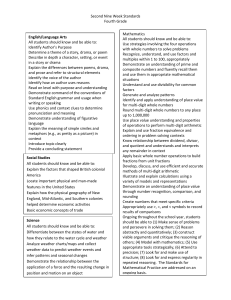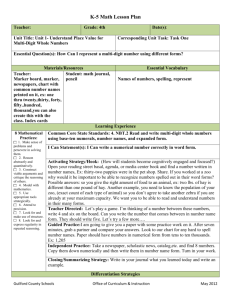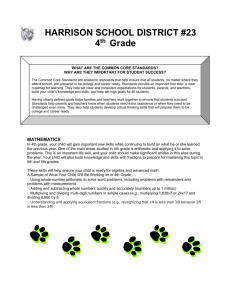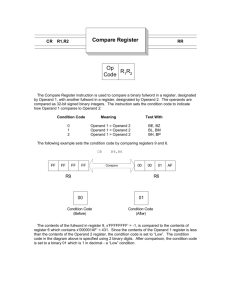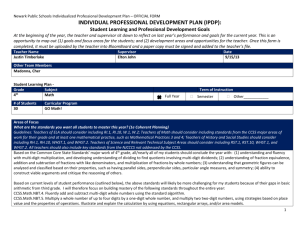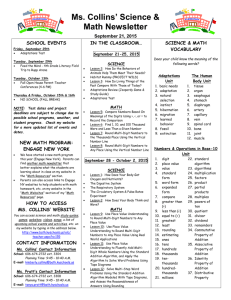Addition Strategies: An Algorithm for Solving Multi
advertisement
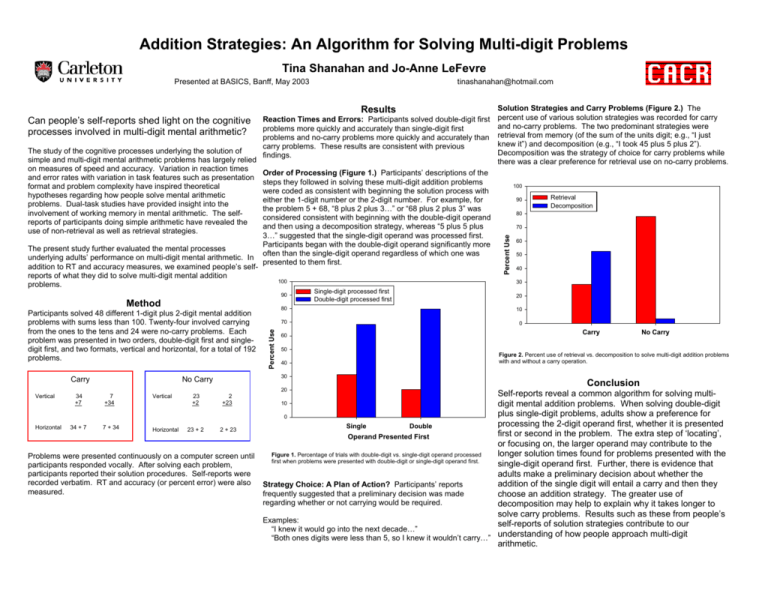
Addition Strategies: An Algorithm for Solving Multi-digit Problems Tina Shanahan and Jo-Anne LeFevre tinashanahan@hotmail.com Results Can people’s self-reports shed light on the cognitive processes involved in multi-digit mental arithmetic? The study of the cognitive processes underlying the solution of simple and multi-digit mental arithmetic problems has largely relied on measures of speed and accuracy. Variation in reaction times and error rates with variation in task features such as presentation format and problem complexity have inspired theoretical hypotheses regarding how people solve mental arithmetic problems. Dual-task studies have provided insight into the involvement of working memory in mental arithmetic. The selfreports of participants doing simple arithmetic have revealed the use of non-retrieval as well as retrieval strategies. The present study further evaluated the mental processes underlying adults’ performance on multi-digit mental arithmetic. In addition to RT and accuracy measures, we examined people’s selfreports of what they did to solve multi-digit mental addition problems. Reaction Times and Errors: Participants solved double-digit first problems more quickly and accurately than single-digit first problems and no-carry problems more quickly and accurately than carry problems. These results are consistent with previous findings. Order of Processing (Figure 1.) Participants’ descriptions of the steps they followed in solving these multi-digit addition problems were coded as consistent with beginning the solution process with either the 1-digit number or the 2-digit number. For example, for the problem 5 + 68, “8 plus 2 plus 3…” or “68 plus 2 plus 3” was considered consistent with beginning with the double-digit operand and then using a decomposition strategy, whereas “5 plus 5 plus 3…” suggested that the single-digit operand was processed first. Participants began with the double-digit operand significantly more often than the single-digit operand regardless of which one was presented to them first. 100 90 Participants solved 48 different 1-digit plus 2-digit mental addition problems with sums less than 100. Twenty-four involved carrying from the ones to the tens and 24 were no-carry problems. Each problem was presented in two orders, double-digit first and singledigit first, and two formats, vertical and horizontal, for a total of 192 problems. Carry Percent Use Method 100 90 70 60 50 40 30 Single-digit processed first Double-digit processed first 20 10 70 0 60 50 40 20 Retrieval Decomposition 80 80 30 No Carry Solution Strategies and Carry Problems (Figure 2.) The percent use of various solution strategies was recorded for carry and no-carry problems. The two predominant strategies were retrieval from memory (of the sum of the units digit; e.g., “I just knew it”) and decomposition (e.g., “I took 45 plus 5 plus 2”). Decomposition was the strategy of choice for carry problems while there was a clear preference for retrieval use on no-carry problems. Percent Use Presented at BASICS, Banff, May 2003 Carry No Carry Figure 2. Percent use of retrieval vs. decomposition to solve multi-digit addition problems with and without a carry operation. Conclusion Self-reports reveal a common algorithm for solving multi10 digit mental addition problems. When solving double-digit plus single-digit problems, adults show a preference for 0 processing the 2-digit operand first, whether it is presented Single Double Horizontal 34 + 7 7 + 34 Horizontal 23 + 2 2 + 23 first or second in the problem. The extra step of ‘locating’, Operand Presented First or focusing on, the larger operand may contribute to the longer solution times found for problems presented with the Figure 1. Percentage of trials with double-digit vs. single-digit operand processed Problems were presented continuously on a computer screen until first when problems were presented with double-digit or single-digit operand first. single-digit operand first. Further, there is evidence that participants responded vocally. After solving each problem, participants reported their solution procedures. Self-reports were adults make a preliminary decision about whether the recorded verbatim. RT and accuracy (or percent error) were also addition of the single digit will entail a carry and then they Strategy Choice: A Plan of Action? Participants’ reports measured. frequently suggested that a preliminary decision was made choose an addition strategy. The greater use of regarding whether or not carrying would be required. decomposition may help to explain why it takes longer to solve carry problems. Results such as these from people’s Examples: self-reports of solution strategies contribute to our “I knew it would go into the next decade…” understanding of how people approach multi-digit “Both ones digits were less than 5, so I knew it wouldn’t carry…” arithmetic. Vertical 34 +7 7 +34 Vertical 23 +2 2 +23
